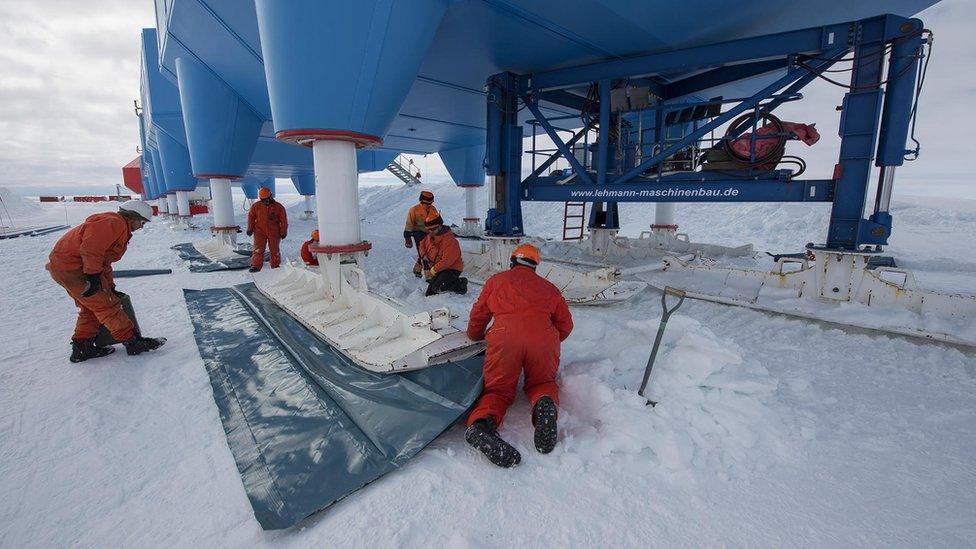UK's Halley Antarctic base set for second closure
- Published

Scientists had been keen to return to year-round operations
The British Antarctic Survey (BAS) will once again close its Halley station at the end of the coming Southern Hemisphere summer.
The base sits on the floating Brunt Ice Shelf, which is currently being incised by two large developing cracks.
BAS withdrew its staff from Halley this past winter because of uncertainty over how these fissures would evolve.
The survey has now confirmed it will do the same again when the approaching summer season comes to an end.
"What we are witnessing is the power and unpredictability of nature," said BAS director Prof Dame Jane Francis.
"The safety of our staff is our priority in these circumstances. Our Antarctic summer research operation will continue as planned, and we are confident of mounting a fast uplift of personnel should fracturing of the ice shelf occur.
"However, because access to the station by ship or aircraft is extremely difficult during the winter months of 24-hour darkness, extremely low temperatures and the frozen sea, we will once again take the precaution of shutting down the station before the 2018 Antarctic winter (March - November) begins."
BAS staff will fly into Halley this week to open it up. One of their key tasks in the next few months will be to install automated experiments that can run in winter temperatures of -50C, and cope with snow and high winds.
The UK has had a permanent presence on the Brunt Ice Shelf since 1956.
Together with the Rothera base on the Antarctic Peninsula, Halley spearheads British activity on the White Continent.
The station gathers important weather and climate data, and it played a critical role in the research that identified the ozone "hole" in 1985.
In recent years, Halley has also become a major centre for studying solar activity and the impacts this can have on Earth.
But its position on a 150m-thick mobile platform of ice has always had a bearing on its operations.

Halley VI's move was made possible by a hydraulic leg and ski system
In the past, as the shelf has moved seaward to calve icebergs, the buildings that make up the base have either been abandoned or torn down.
New structures have then been built "upstream".
The latest incarnation of the station, Halley VI, external, is somewhat different in that it incorporates legs and skis that allow it periodically to be towed to a new location.
Its first big move took place in February, to get the base behind a large chasm that had started opening again after more than 30 years of dormancy.
But it was a timely decision because another crack (known as Halloween crack) had also begun moving across the ice.
And both fissures, which threaten at some point to spawn colossal icebergs, have continued to propagate through the winter.

Scientists use ground sensors and satellites to monitor the cracks
In a report published this month in the journal The Cryosphere, external, BAS scientists said the future behaviour of the Brunt shelf now depended on how the two cracks interacted with a series of bumps on the seafloor known as the McDonald rumples. These are a pinning point for the shelf and act to buttress it.
If calving results in a substantial loss of ice around the rumples then the whole shelf will speed up. A similar event in the early 1970s led to a two-fold increase in flow velocity.
The early operations team going into Halley this week will be followed by a larger group of staff on the Royal Research Ship Ernest Shackleton, which will come in from Cape Town and moor up against the ice shelf to unload supplies.
BAS director of science Prof David Vaughan said researchers had already planned for the possibility of another winter closure, and would set up a kerosene-fuelled generator to power automated instruments.
"It is, I should stress, at this stage just a prototype power system," he told BBC News.
"For it to keep running at -50C with nobody around to chip the ice off it or keep the snow away from it will be a significant challenge.
"But if it works and the instruments attached to it keep working, then we will collect several of the data streams that would otherwise have been lost, including the ozone measurements."
BBC Horizon: Halley VI is one of the most remote scientific research centres in the world
Jonathan.Amos-INTERNET@bbc.co.uk, external and follow me on Twitter: @BBCAmos, external